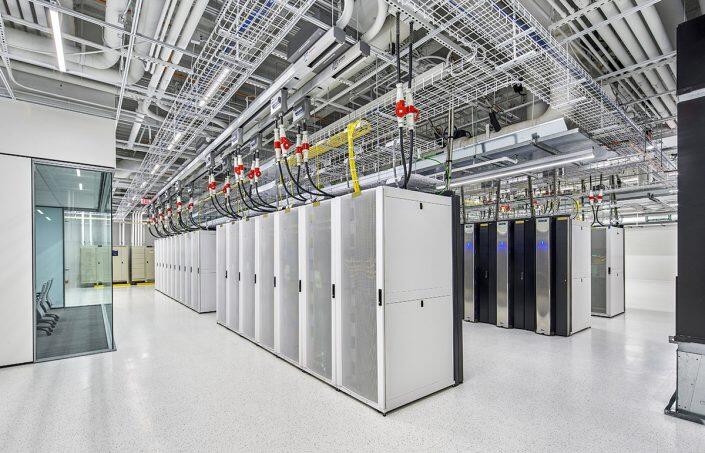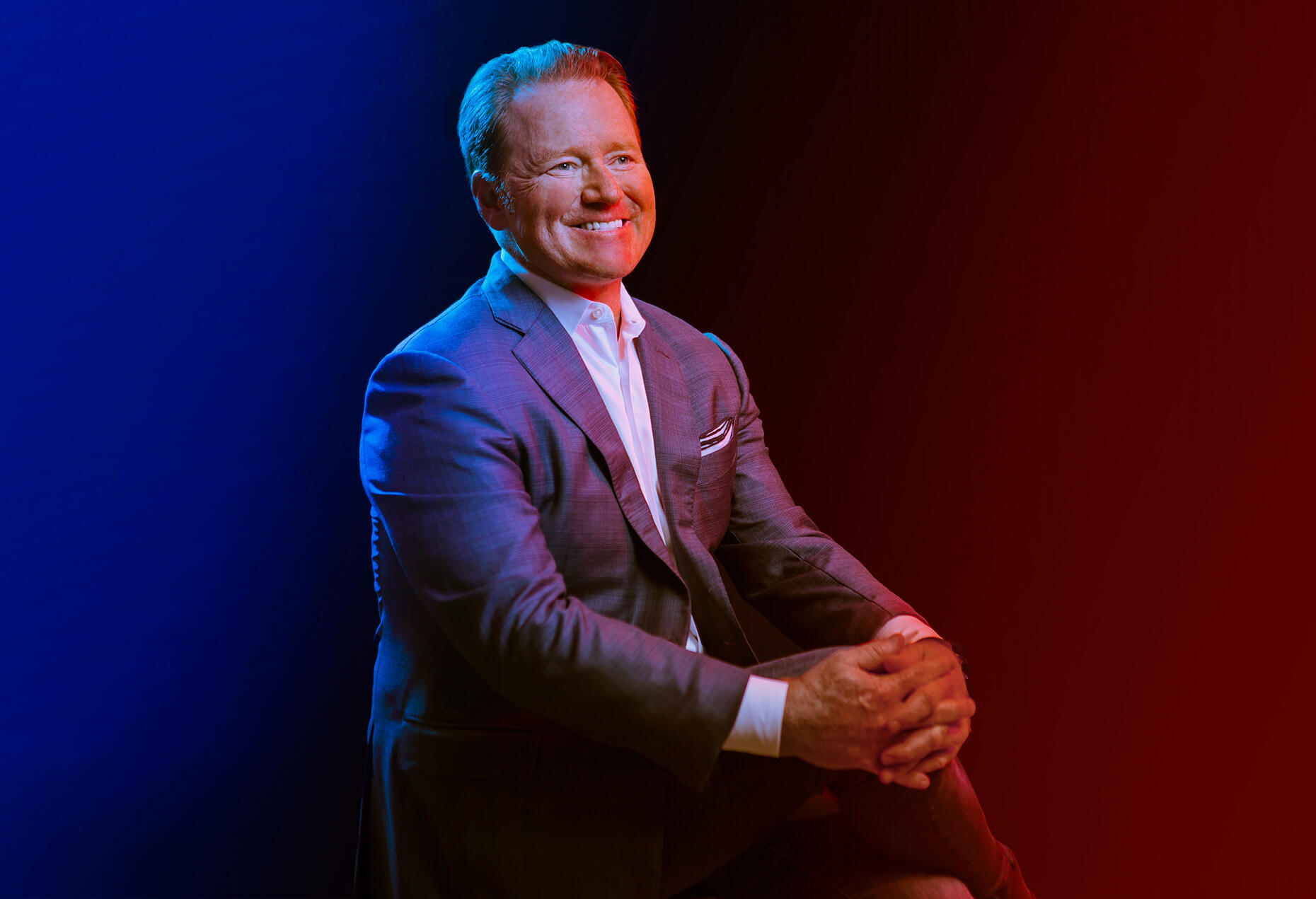Entering an office building in the future, according to Marc Ganzi, will look something like this:
“There won’t be security anymore. You’ll flash a bar code, it’ll say, ‘Yup, the elevator’s been activated, you have a meeting at 11 o’clock, you’re going to go to the 27th floor and get in Cab E.’ Everybody has some sort of fitness attachment that says what your heart rate is, where you’re going, how many steps you take. We can use thermal imaging to figure out the emissions each person is using. We know how to optimize the HVAC and lighting and can really bring down the total consumption in the building.”
At home, the same deal. “The minute you enter your apartment, it’s already predicting your favorite show to watch. It’s delivered the right amount of Pellegrino, butter, eggs, whatever. Every morning when you get on your Peloton, it knows that you want to watch CNBC. You always have the capability to say, ‘No, thank you, I’m going to turn it off.’ But we’re creatures of habit, we like what we like. And generally speaking, 90 percent of those decisions we’d certainly like made for us.”
Ganzi’s not merely spinning prophecies about this smart-building future. He’s betting the farm on it.
His firm, Colony Capital, is in the midst of one of the most consequential shifts in commercial real estate history, going from a portfolio of 80 percent hotel, office, warehouse and retail to one of about 70 percent digital-related assets such as data centers, cell towers, small cells and fiber-network properties. That’s $32 billion worth of digital infrastructure that Ganzi believes will underpin the new, on-demand economy.
Colony acquired Ganzi’s firm, Digital Bridge, in 2019. Ganzi succeeded industry titan Tom Barrack as CEO of Colony last July and moved the firm’s headquarters from Los Angeles to his home base of Boca Raton this January. Under him, the firm’s share price has tripled, while its much-maligned leverage has been halved. As of February, Colony had raised $4 billion for its second digital-infrastructure fund, Bloomberg News reported, with a target of $6 billion.
The Real Deal caught up with him to discuss Colony’s digital transformation, how real estate will embrace the “internet of things” and how cities must adapt.
Colony is unrecognizable from a few years ago. When leading a wholesale transformation of a giant company, where do you begin?
Once the cloud enabled e-commerce and goods and services to travel more efficiently, it allowed people to rethink different types of real estate models beyond just fintech or proptech or even digital infrastructure. When we made that joint venture with Colony back in 2017 , we raised $4 billion in 10 months, which was a record for a first-time fund.
We’ve now deployed that fund. It’s been very successful, and the world has taken notice. Some of that transformation was certainly enabled and perhaps accelerated by Covid. But all of the thematics that we’re pursuing now in our digital real estate business revolve around the future of where we see the world going. As we think about 5G, we think about cloud computing, artificial intelligence, IoT networks and edge computing. These are going to be the next big real estate models over the next decade.
A lot of people have stayed from old Colony. And the reason we were able to move some of those people into the digital businesses is because the underlying premise of our entire business is keeping tenants happy. And whether you’re signing an apartment lease or you’re signing a lease in a medical office building or an industrial property, the principles that existed at Colony Capital for 30 years are no different than what existed at Digital Bridge for 27 years: We have great customers, we have to service them, we want long-term leases and we want to be the landlord of choice.
It’s almost like Coca-Cola going to Wall Street and saying, “Hey, we’re going to be the No. 1 purveyor of a healthy lifestyle.” How did you gain the confidence of investors?
I had to reestablish a rapport with the Street. The firm had undergone a lot of distraction. [Last May, it defaulted on $3.2 billion of debt secured by hotel and health care assets.] And my job was to remove the distractions, remove the noise and begin to have a dialogue.
I told investors, “There’s five things we’re going to do, and we’re going to execute them ruthlessly and you have to trust me. And trust is earned, it’s not given. So if you don’t believe in our story, that’s fine, but we’re going to get there.”
I told them that I would rotate our asset base. I would get from 80 percent traditional real estate to 60 percent digital. We actually rotated $48 billion of assets under management last year. It was just heroic.
Selling office buildings and retail properties and industrial in the pandemic was not easy. And then we sold our hotel portfolio [the Khimji brothers’ Highgate bought the nearly 23,000-key portfolio for $67.5 million and assumed $2.7 billion in existing debt on the properties]. We exited a lot of core verticals in what’s arguably been the most difficult environment in commercial real estate since 2008.
I inherited a balance sheet that was levered at about 12 times. [We’ve] taken net leverage down to six times. I had 27 offices, 500 employees. And I was like, “This is madness. We just don’t need this many people.” We took a lot of costs out of the business. We closed a lot of offices. We sold the corporate plane.
The fourth thing we said we would do is we would grow. For the first time in many years, we would provide organic growth. And then the last thing I said I’d do is change the culture.
When you own the digital infrastructure, you control so many nodes that are going to be key in the new economy.
The first digital wave hitting was about consumer-to-consumer, voice communications, data. As we turned the corner and moved to more of a cloud-based environment and faster digital throughput in 3G and 4G, it was this notion of, “Okay, it’s no longer C2C, maybe it’s consumer-to-enterprise or B2B.”
This next decade will be defined by D2D [device-to-device]. And so we talk a lot about device learning. We talk about IoT networks. Think about a Tesla. It consumes four gigabytes of data per day — that’s a driving data center. On a given day, it can touch 2,500 IoT sensors in its journey. It’s communicating perpetually to the cloud.
What are you listening to? How did you drive? Oh, by the way, when you’re in that shopping center and you get back in the Tesla, it reminds you, “Oh, you didn’t go to the dry cleaners and get your wife’s dress.” That stuff is not science fiction — that’s happening today.
We spend a ton of time talking to commercial property owners about this. How is IoT going to change the office-building environment? What’s your elevator cab management? What’s your lighting system management? How can you use all of those transactions that are happening in an office building to create a more efficient environment where we can bring greenhouse gas emissions down by 20 to 30 percent over the next 10 years?
This is surely what Bob Sulentic is thinking about at CBRE right now: How do we bring a better user experience, but at the same time how do we reduce our carbon emissions? We all have the same responsibility to the planet and to our investors. And the way we get there for the next 10 years is exactly that — big data analytics, data mining, IoT sensors, artificial intelligence and helping real estate make better decisions.
Emissions — what New York’s climate law is built on — are not necessarily a great indicator of energy efficiency in a building. You need to understand what goes on in those buildings. I wonder if you can play a role in getting buildings to a point where each one has bespoke energy usage reports.
Look at what we’re doing with cars. Five years ago, cars were not looked at as a data center. I didn’t think we were doing data mining in automotive, but we are. And it’s helping us make decisions in how the cars ultimately operate, the routes that they take, the efficiencies. The same thing is going to happen in commercial real estate. And it is happening, I think, is the punchline.
I’m from New York. I have a deep passion for the city. And New York has a rich history of creating regulations that almost get in the way of itself. For New York to repair itself, it’s going to have to be enabled through digital. A lot of what will bring it back is understanding how digital can transform the city and make it a better place to live.
We’ve seen other big American cities suffer because they haven’t adapted, Detroit being one of them. And then you look at a city like Miami, incredibly dynamic, embracing technology and digital and change. And companies are moving here in droves.
We’ve done a lot of work with the city of Pittsburgh, Carnegie Mellon and Uber, with autonomous vehicles that drive around the city, creating centers of innovation on edge computing by using data centers on the periphery of the network to create better user experiences. So cities that understand digital and understand what to do are going to move forward. Cities that don’t are going to move backward.

A Colony Capital data bank in Atlanta
I was grappling with how to value assets in your space. If you own an office building in Grand Central — pre-pandemic, let’s say — you can map out rent appreciation and come up with a valuation. But with digital infrastructure, asset values can escalate much more rapidly if the digital ecosystem built on them gets richer.
There are four key value drivers. One is the scarcity of the permits. The second is the quality of the underlying cash flows, just like traditional real estate — a 25-year lease with Verizon is better than a three-year lease with T-Mobile. Third, growth drivers are very important in digital. So if it’s a data center and you keep adding more racks each year, and those racks exponentially increase the rents, that affects the cap rate. A high-growth digital asset is going to command a very, very tight cap rate.
The fourth thing is how you finance. You talked about owning that really great office tower in the center of Midtown. You can securitize that super-tight because 80 percent of the rent roll is investment-grade. And the weighted average office lease is eight years in duration. You know where that’s going to price.
The same thing is happening in digital real estate. Bondholders are moving to digital real estate because they like the duration of the leases, they like the quality of the cash flows and they like the predictability of the earnings, which they’re not getting in traditional real estate anymore because of this disintermediation that you and I talked about.
So permitting, contract duration, growth and financing are the four vectors that impact value. And if you hit on all four, an asset is worth 30 times or 40 times cash flow, which is crazy.
Look at fintech. When companies like Stripe started out, they had this total addressable market figure in mind and aimed to capture a slice of it. But what even they couldn’t account for is that the entire market changed — Stripe is now worth more than the entire fintech market was worth when it launched. Is there an element of that in your business — that if a couple of things happen in the digital ecosystem, this tower isn’t worth 1.2X, it’s worth 10X or 20X?
I’ve spent the first year [as CEO] just rebuilding trust. We finally get to play offense. If cloud computing continues to grow at 20 to 25 percent [compound annual growth rate], our cloud data centers on our balance sheet are going to be worth 20 to 25 percent more in a year. It’s easy to do that math.
With edge computing, we’re in the first inning. And we’re the largest developer and owner of edge data centers today. We have 68 centers, and that business has double-digit organic growth.
And then having networks that service 5G and IoT networks and help drive some of that artificial intelligence, that’s also super important. So we’re working both sides of the fence at the same time, but the key is to be in the landlord business where your tenants are growing. You’ve got to skate to where the puck is going.
And you’re attacking it from a really interesting perspective. One, you own some of these assets. Two, through your fund, you’re able to invest in some of these companies delivering those services. It seems like more than just owning the real estate. You’re trying to sit at the center of that ecosystem.
We want to be the enabler of converged networks. That’s where we sit at the corner of State and Main in digital. I think the stuff that we’re doing in the future is how do you enable connectivity to the next level? And how do we bring connectivity closer to the consumer, closer to ultimately an enterprise? And then ultimately, closer to the device? A lot of that is happening in what we call edge computing. It works well in a downtown environment, but not on the edge of a network. Our mission is to build that infrastructure, provide that connectivity. And then if we can go a layer deeper and actually help operate the core of the network and make it more efficient and lower the cost for the carrier and for the cloud provider, then we’re providing that next level of connectivity. And that’s interesting because really, that’s not a place where digital REITs have historically gone.
What do you think the [total addressable market] for your business is? Since we’re straddling the realms of real estate and infrastructure here.
Last year the TAM grew by $387 billion. That’s what was spent last year on digital infrastructure — towers, small cells, fiber and data centers.
And you guys did about 8 percent of that.
Correct. Our goal is to do 5 percent every year. And this year [total spend] will be $396 billion, and next year it’ll be $414 billion. So you just look at that and in three years, that’s $1.2 trillion in new CapEx that’s just gone into the ground. Every year we keep compounding and adding to that. And I just don’t see that slowing down. I think you’ve got a TAM that was a couple of trillion dollars a decade ago. Five out of the top 10 biggest REITs in the world today are digital REITs.
With the growth of e-commerce and industrial, how does your business change?
It’s smart logistics, it’s understanding that the design specifications of a new industrial property have to have different ceiling heights, you have to have different size loading docks for autonomous driving vehicles. We’re going to have drone pads taking off and landing. You’ve got to have IoT sensors throughout the entire industrial park, because as an Amazon truck drives in, you want the IoT sensor to track everything that’s on that truck before it gets to the property. So when it arrives, you have every SKU code, you know exactly where the goods are going and what goods are coming in.
A great enabler of that is CBRS (citizens broadband radio service) radios, the new technology that the FCC just launched. So what we can do as property owners is we can set up wide-area networks. We can deploy the CBRS radios. And you can use it for IoT, you can use it for inventory management, you can use it for workflows and process management, you can run your email off it, you can run your comms. So the ability to bring wireless and applications together and then impact the enterprise is where industrial real estate is going.
Imagine a huge port. Hundreds of thousands of containers coming in and out every day, and ships waiting 2 miles offshore. IoT sensors knowing what’s on those ships because they’re picking up an RF code, an SKU code inside that shipping container. By the time that ship comes into port, every good has already been mapped.
We’re working with Homeland Security to define which container is sensitive and which one’s pre-cleared. So now you’re speeding up supply chain. If you can make a ship turn 25 percent faster you can ultimately get goods and services going to a place faster with zero human intervention. These are autonomous cranes putting shipping containers onto rail carts, putting them onto 18 wheelers that drive autonomously, boom, they’re gone. That’s next-generation thinking.
You couldn’t solve the Suez canal crisis, but you can do a lot of other things.
But that’s what they’re doing in Panama. They’re trying to figure that out because right now in Panama, you’ve got goods and services that sit for 10 days outside the canal. That doesn’t work. So we need to use technology to enable that.
This interview has been condensed and edited for clarity.
(Write to Hiten Samtani at hs@therealdeal.com. To check out more of The REInterview, a series of his in-depth conversations with real estate leaders and newsmakers, click here.)



